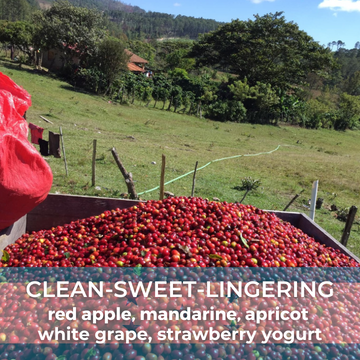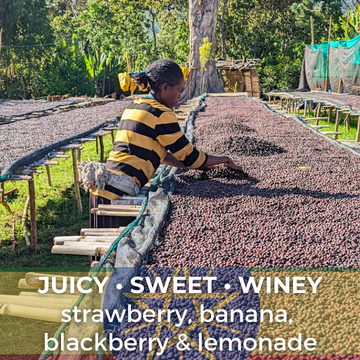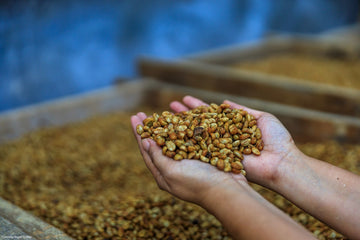How to Rest and Store Fresh Roasted Coffee
How Long Should I Rest My Fresh Roasted Coffee?
Ahh the age old question: "How long does coffee need to rest after roasting?" I get an email at least once a week asking this question and I don't know why it's taken so long to just write an article I could link to. Well, that's not really true, I do know why. It's because my views on resting (along with the rest of the "Pro" coffee community) have shifted significantly over time. And honestly, I never really felt great about giving a definitive answer, so I typically advised something vague like "72 hours is a good rule of thumb!" or "the lighter the roast, the longer the rest!".
But it's time to set the record straight, I finally have clear answers! Which will be complicated, nuanced and likely edited over time...and that's a lesson worth learning in and of itself! Like the search for all knowledge, our understanding of coffee is constantly evolving and shifting as we learn more and new theories are tested. With that in mind, I'll do my best to give some clear and concise guidelines. The key word there is guidelines! Because as I always say, everyone's goal with coffee is a little different so feel free to use these concepts as a starting point but don't be bashful about experimenting to find the cup you're looking for. As part of this discussion, I'll share an experiment we did recently on resting that has been very eye opening into just how many factors are at play in the "great rest debate". But first! Let's start with the guidelines and work backwards from there.

1. Roasts seem to degas (or rest) faster when they begin the roasting process from room temperature.
Most commonly associated with air, or fluid bed roasters, which begin the roasting process from room temperature, rather than in a preheated roaster (usually a drum roaster). Now I can't explain the chemistry taking place here, and I'll readily admit this is the single most controversial point I'll make in this article. All I can do is trust my tongue and tell you that we, along with some other industry professionals have found: coffees roasted in non-preheated roasters seems to reach peak cup quality much faster.
We have been noticing this phenomenon for a while now when testing roasts in our Fresh Roast SR800 and our Aillio Bullet R1 V2. When testing different roast methods in the Aillio, we cupped and brewed pretty early in the rest cycle like we were used to with our Fresh Roast tests, but often found we didn't like the cup. We thought we were doing a terrible job roasting with the Aillio! But days later, we'd give the roasts another chance in the cup and we were very happy with the results. After several of these observations, the pattern began to emerge: the coffees needed much long to rest post-roast than we were used to. But why? Was it the larger batch size of the Aillio? Was it due to a design element? Where we roasting poorly? Or was it an Air Roaster vs Drum roaster thing?
Well as luck would have it, a few months ago, we met the newest roaster in our lineup, The Nucleus Link (watch the review and guide here). And one of the biggest claims Nucleus made about this roaster was what they called "on-demand" or "Ready To Drink" roasting. Simply put, the Link produced roasts ready for peak brewing way faster than conventional drum roasters. But how? In an interview with Roast Rebels, the head developer on the Link project Sam Corra, admitted he wasn't sure how! It was a discovery they made during development, a happy accident if you will. But all their testing led them to one obvious conclusion: beginning the roast at room temperature allowed the gasses generated in fresh roasted coffee (mostly Carbon Dioxide or CO2) to build up less and release quicker. And the only roasters that can begin the roasting process from room temperature and still reach development in a reasonable period of time are, you guessed it, fluid bed roasters like the Link and SR800.

Finally, an explanation to the pattern we'd observed! And in typical TCC fashion, we had to test this for ourselves. So we choose two coffees, a traditional washed Costa Rican coffee and an intense anaerobic natural El Salvador, in order to represent the two extremes of coffees we commonly roast. We roasted both as closely in profile and roast level (15% development with the Costa Rica and 12% with the El Salv) as possible in the Link, the SR800 and the Aillio Bullet. We then proceeded to cup all 6 samples (nearly) every day for 2 weeks. And sure enough, the roasts in the Link and SR800 were tasty and "peak" in terms of flavor, body, texture, balance, etc several days to a week before the Aillio Bullet samples!


The washed Costa Rica samples roasted in the Link reached peak on day 3 having been roasted medium-light. Peak for us means that the coffee attributes (flavor, body, balance, acidity, etc) had improved and then settled, being mostly unchanged after that point. The SR800 reached peak on day 4 and the Aillio's sample didn't peak until day 8. With the anaerobic natural El Salvador, we reached peak on days 6, 7 and 14 with the Link, SR800 and Aillio respectively. Again, I couldn't explain the science here and much more side by side testing would be needed to confirm this theory. But the pattern seems clear to us and worth building into our resting protocol so expect an update here in the future as more testing (and resting) is done!

2. There are no rules in roasting, only guidelines based on experience.
There's a lot happening under the hood when you roast coffee. Chemical reactions taking place, sugars caramelizing, volatile organic compounds forming and other fancy schmancy science stuff. This whole carefully crafted ballet is complicated by the fact that every different cultivar of coffee has a slightly different chemical composition. Add to that crazy processing methods like "double fermented anaerobic natural process" which have a massive effect on the beans and your head just starts to spin with the variables and possibilities. Which is fun but a little overwhelming! The point is, there's too much going on here for rules that will apply to everyone all the time, so please understand this is just meant to be a helpful starting point. From here, make adjustments based on what works for you and the cup you're looking for. Make your own rules, it's your coffee after all!

3. Cup quality and "peak" brewing is not an on/off switch.
It's important to keep in mind that while your coffee is resting, it doesn't suddenly go from gross to tasty between days 4 and day 5. During the rest period it will increase in quality gradually. With some roasts this will happen in a fairly linear manner, steadily getting tastier each day. Other times it will be exponential, meaning the last day or two leading up to peak will see a massive increase in cup quality. This is also why I believe that the Link's "ready to drink" claim is valid, if a bit of an exaggeration. With such a fast resting time and with this gradual increase in cup quality over the rest period, it can safely be concluded that the cups from a non-preheated roaster will indeed be tastier very quickly after the roast, they just might take a few days to reach "full peak" quality. Feel free to drink your roast daily over the course of your rest time to enjoy experiencing it's evolution from too fresh to well rested!

4. Coffee should stay around peak quality for 4-6 weeks if stored properly.
Ahh yet another common question: how should I store my coffee? These are fresh roasted coffee's worst enemies:
A: Grinding - Grinding exponentially increases surface area, which exponentially increases the staling effects of everything else on this list! So grind just before brewing.
B: Oxygen - Despite being awesome for our lungs, oxygen is one of coffee's worst enemies. Keep coffee in a sealed container or bag. Ideally that container should have a 1-way valve to allow the carbon dioxide released from the coffee during resting to escape while keeping oxygen out. If you don't have a valve, "burp" your container daily for a few days by briefly opening it, then closing it again.
C: Moisture - This one should come as no surprise. You want to keep your coffee dry to keep it fresh, so again, a sealed container or bag should do the trick. If you live in an especially humid climate, keep your coffee in a room of your home that is air conditioned.
D: UV Light - Sunlight damages our skin so of course it damages coffee! It's best NOT to leave your coffee on the counter in a well lit room in a clear container. If you are using clear containers, keep it in a cabinet.
Bonus points: NEVER store your coffee in the refrigerator. It's stinky in there and coffee absorbs smells from the environment just like baking soda. The freezer is a controversial choice. If you do store roasted coffee in the freezer, it's best to use single serving containers. If you are using a large bag in the freezer and keep pulling it out to dose from, condensation will gather in the bag which allows moisture in each time you pull the bag out of the freezer and open it to the elements. Otherwise, freezing coffee will significantly increase it's peak brewing window.
To summarize: store your coffee in a sealed bag or container, ideally with a 1-way valve in a cool, dark, dry place.








